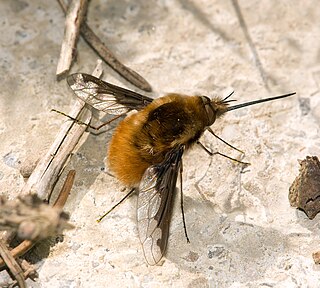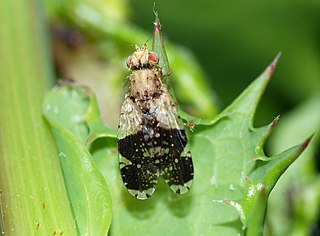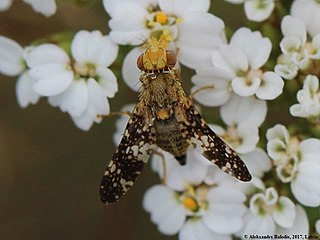
The Bombyliidae are a family of flies. Their common name are bee flies or humbleflies. Adults generally feed on nectar and pollen, some being important pollinators. Larvae generally are parasitoids of other insects.

Argyra is a genus of flies in the family Dolichopodidae. The name "Argyra" comes from the Greek word for "silver".

The Richardiidae are a family of Diptera in the superfamily Tephritoidea.

Dolichopus is a large cosmopolitan genus of flies in the family Dolichopodidae. Adults are small flies, typically less than 8 mm in length. Nearly all species are metallic greenish-blue to greenish-bronze. It is the largest genus of Dolichopodidae with more than 600 species worldwide.
Hendrella is a genus of tephritid or fruit flies in the family Tephritidae.
Oedaspis is a genus of tephritid or fruit flies in the family Tephritidae.

Tephritis is a genus of flies. It contains around 170 described species, making it the sixth largest genus in the family Tephritidae. Many more undescribed species are known from specimen collections. Tephritis occur throughout much of the world, but most are Palearctic. They can be found in a wide range of climate types, from hot semidesert to tundra. Most species inhabit the inflorescences of plants from several tribes in the family Asteraceae, and a few species cause galls to form.

Urophora is a genus of tephritid or fruit flies in the family Tephritidae.

Euaresta is a genus of flies in the family Tephritidae that live in plants of the closely related genera Ambrosia, Xanthium, and Dicoria, and feed on their flowers and seeds.

Oxyna is a genus of fruit flies in the family Tephritidae. There are at least 20 described species in Oxyna.
Urophora terebrans is a species of tephritid or fruit flies in the genus Urophora of the family Tephritidae.

Liancalus is a genus of flies in the family Dolichopodidae. It contains at least 21 species distributed worldwide except in Australasia and Oceania. The genus includes some of the largest species in the family, with body length approaching 12 mm in some species.
Nematoproctus is a genus of fly in the family Dolichopodidae. It has an uncertain position in the family; different authors have included the genus in the subfamily Diaphorinae or the subfamily Rhaphiinae.

Herina is a genus of flies in the family Ulidiidae. It is possibly the largest genus in the family.

Empis is a genus of dance fly, in the fly family Empididae. It contains the following subgenera and species:

Laphriinae is a subfamily of robber flies in the family Asilidae. There are more than 110 genera and 1,000 described species in Laphriinae. Larvae of the genus Hyperechia are known to grow inside the cells of Xylocopa bees, feeding on their larvae.

Gymnopternus is a genus of flies in the family Dolichopodidae. It was formerly placed as a subgenus of Hercostomus, but is now accepted as a separate genus.

Diogmites is a genus of mainly neotropical flies in the family Asilidae or robber flies.
Laphystia is a genus of robber flies in the family Asilidae. There are at least 50 described species in Laphystia.
Lyroneurus is a genus or subgenus of flies in the family Dolichopodidae. Its rank is not currently certain; it has variously been placed as its own genus or as a subgenus of Diaphorus. More recently, it has been suggested by Pollet et al. (2004) to be a synonym of Chrysotus, but some authors maintain generic rank noting that Chrysotus is possibly paraphyletic.














